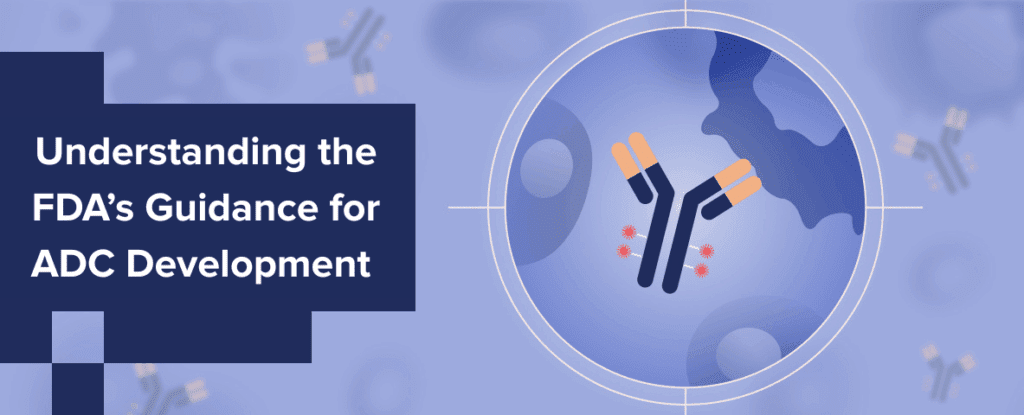October 24, 2025

Antibody-drug conjugates (ADCs) have emerged as one of the most promising modalities in oncology treatment, and with more than 15 ADCs approved by the FDA (as of May 2025), they are now firmly established as a proven therapeutic class. To support the growing number of ADCs in development, the FDA issued its first dedicated guidance on clinical pharmacology considerations for ADCs in March 2024, bringing together decades of experience to provide developers with a clearer framework for evaluating these complex therapies throughout clinical development.1,2
So what does this guidance mean for ADC development? And what do developers need to do to meet these expectations
The FDA guidance: understanding the ADC as a sum of its parts1
The new FDA guidance makes it clear that ADCs must be evaluated as multi-component products, as the antibody, the payload, the linker, and any relevant metabolites all contribute to overall safety and efficacy. Evaluations across a clinical pharmacology program must therefore account for the contribution of each component, not just the ADC as a whole. As a result, sponsors are expected to measure each element with validated assays throughout ADC development and provide justification if any are excluded.
The guidance sets expectations across all the core areas of clinical pharmacology: bioanalytical approach, dose– and exposure–response analysis, intrinsic factors, QTc assessment, immunogenicity, and drug–drug interactions. Within this framework, the evaluation of intrinsic factors is a critical consideration, as it captures how patient characteristics, including genetic variation, may influence the behavior of ADC components.
Intrinsic factors and pharmacogenomic considerations
A notable inclusion in the intrinsic factors assessment is the expectation to evaluate pharmacogenomics. The FDA highlights that patient genetics can influence ADC exposure and response—for example, functional variants of enzymes and transporters such as CYP2D6 or BCRP can alter clearance of the unconjugated payload, while Fc-gamma receptor (FcγR) variants may affect antibody-mediated activity. Depending on an ADC’s mechanism, and absorption, distribution, metabolism, and excretion (ADME) profile, a pharmacogenetic evaluation may be recommended to capture these influences.
One area where pharmacogenomics may be particularly relevant is linker stability. ADC payload release relies on cleavage of the chemical linker, a process that can be mediated by enzymes, reduction, or pH-dependent hydrolysis. Reflecting this, the FDA calls out linker-derived analytes in specific assessments, such as QTc risk evaluation, where sponsors are expected to analyze the impact of the unconjugated payload, metabolites, and the linker itself. In practice, this means developers may need to incorporate pharmacogenomic data into studies that examine payload release and exposure, ensuring they capture the impact of patient variability on this critical step of ADC function.
What does the pharmacogenomics guidance mean for ADC development?
For ADC developers, the guidance raises the bar on clinical pharmacology planning. Programs should now:
- Expand bioanalytical coverage to support pharmacogenomic analyses, with assays that assess, not just the intact ADC, but also the antibody, linker, payload, and relevant metabolites, with clear justification if any are excluded
- Build pharmacogenomics early into study design, particularly where genetic variants may affect payload clearance or antibody function
- Account for linker stability in pharmacogenomic assessments, including specialized studies such as QTc evaluations, where regulators expect to see data on both payload and linker analytes
Meeting these expectations will require more detailed planning and earlier integration of component-level assessments into ADC development programs. Teams that prepare for these requirements early can reduce regulatory risk and maintain momentum through development.
Find out more about how CellCarta can support your ADC development programs
References
- https://www.fda.gov/regulatory-information/search-fda-guidance-documents/clinical-pharmacology-considerations-antibody-drug-conjugates-guidance-industry
- https://www.fda.gov/drugs/guidances-drugs/guidance-recap-podcast-clinical-pharmacology-considerations-antibody-drug-conjugates
About the author:

Nathalie Bernard (PhD) is the scientific business director for the Genomic Services unit within CellCarta. Her background is in molecular biology, and she has many years of experience in PCR and sequencing, technologies used to discover or identify DNA and RNA biomarkers of clinical utility. At CellCarta, Nathalie is using her expertise to guide our customers in finding the best solution to their genomic questions.
You might also be interested by
CellTalk Blog
This is SPARTA: A Framework for Multiplex Immunofluorescence Analysis
November 13, 2025
More infoPosters
Artificial Intelligence-powered Spatial Analysis of Tumor Microenvironment Identifies Immune Phenotype in Non- Small Cell Lung Cancer, Colorectal Cancer and Urothelial Cancer.
October 30, 2025
More infoPosters
Combining high-plex proteomics with single-cell transcriptomics for deep characterization of antigen-specific T cell responses
October 30, 2025
More infoCellTalk Blog
Tregs in Focus: How a Nobel-Winning Finding is Shaping Clinical Research
October 22, 2025
More info